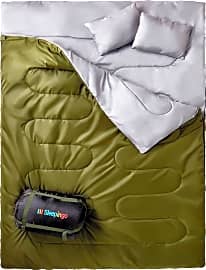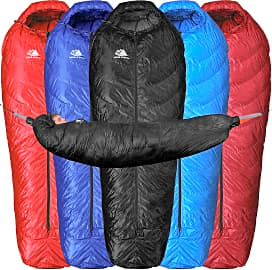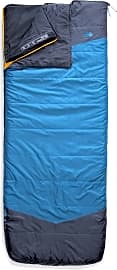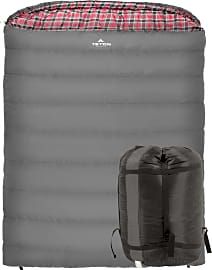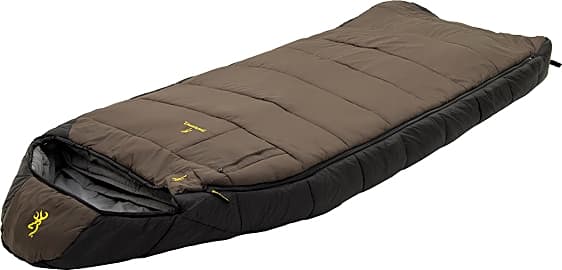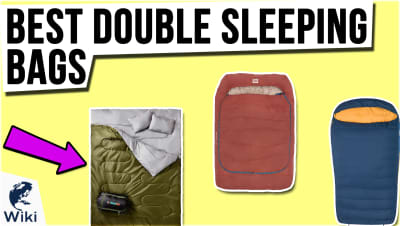The 10 Best Sleeping Bags

This wiki has been updated 41 times since it was first published in March of 2015. Keep yourself warm and dry on your next adventure with one of these comfy sleeping bags. From mummy to classic flannel, the styles we've selected offer a range of protection options, so whether you’re hiking the Appalachian Trail or glamping with your family in a yurt, there’s sure to be a model that suits your needs. We've chosen our favorites based on value, heat rating and overall quality. When users buy our independently chosen editorial choices, we may earn commissions to help fund the Wiki.
Editor's Notes
February 01, 2021:
People go camping in all kinds of weather, so we have made sure there are options here to suit every climate. While many models are suitable for use in more than one season, few sleeping bags are as adaptable as The North Face Dolomite One Bag, which comes with two layers of insulation that you can zip on or remove as needed. In the weight department, the Naturehike Ultralight is top contender, while the Sleepingo XL and Teton Sports Mammoth are best for couples and families that want to cuddle together for extra warmth. Those looking to avoid sleeping on the ground, yet still stay nice and toasty, should turn to the Hyke & Byke Crestone, which features drawstring openings on both ends that you can string a camping hammock through.
June 03, 2019:
In this update, we've bumped the Kelty Cosmic and US Army Genuine Issue up to #2 and #4, respectively. The latter model is quite expensive, but it is the sleeping bag most capable of handling extreme weather conditions. The Kelty Cosmic, a favorite amongst backpackers, offers excellent performance at a good price.
We've added the Nemo Disco to our list and placed it at #1. Our previous top pick, the Browning Camping McKinley, is a great bag, but in recalibrating this list's priorities, we decided to demote it because it simply isn't versatile enough for multi-season use. The Nemo Disco, on the other hand, will suit a varied range of temperatures — even warm ones, thanks to its vented zippers.
We decided the Coleman Comfort Cloud no longer belonged on our list. Though we didn't discover any major design flaws, it simply didn't hold up to the quality of newly-considered models — namely, the Nemo Disco.
Special Honors
Feathered Friends Flicker UL 20 This American-made hybrid quilt/sleeping bag will appeal most to outdoors adventurers due to its lightweight design and its versatility. A zipper runs the length of the bag, so it can be fully unzipped and used as a quilt on warmer nights, or zipped all the way up and used as a standard mummy-style bag in colder temperatures. It features 950+ fill power down, continuous baffles to allow for custom adjustments to the down placement, and a footbox drawcord to cinch it tight for better insulation. It's a great choice for both tent sleepers and hammock campers. featheredfriends.com
UGQ Bandit Marketed as an alternative to traditional sleeping bags, this made-to-order quilt is lauded in the ultralight community for its performance and construction quality. The company offers many customization options, including temperature rating (from 50 °F all the way down to 0 °F), down fill power, length, and width. There are also a myriad of color options to choose from. At under 1.5 pounds, it is a fantastic option for those trying to cut down on pack weight. If you sleep on your side, this design will offer more comfort than a mummy bag. ugqoutdoor.com
Sleep On It, Then In It: Choosing A Great Sleeping Bag
Trust us, when all your gear -- including food and water -- already weighs forty pounds or more, you'll understand why that extra cost was worth it.
Choosing the right sleeping bag involves the consideration of many factors, but the two primary concerns are simple. They can be referred to in terms of temperature and weight. That is to say how cold are the temperatures from which the bag must protect you, and how much can your bag weigh before it becomes a burden instead of a boon.
If you are choosing a sleeping bag for basement sleepovers or for friends crashing on the couch, these factors are in fact not very important. Go ahead and choose a big, comfortable sleeping bag that will act as much like a comforter or quilt as a carefully designed piece of gear. But if you're a climber, hiker, camper, or a prepper looking to outfit a survival pack, temperature and weight are critical concerns. Indeed, they far outweigh comfort in terms of importance.
So, first look at a bag's degree rating. For example, sleeping bags rated at 30 degrees Fahrenheit should be able to keep a person warm enough for safety (if not comfort) at temperatures just below freezing. But make sure you factor in issues like windchill when considering what degree rating is suitable for your purposes. If you regularly camp out on glaciers or cliffs, then you might need a bag rated well below the freezing mark. (Indeed, some superlative sleeping bags are rated at sixty degrees below zero!)
A sleeping bag that is too heavy or bulky to easily fit in with the rest of your camping gear isn't a savvy choice no matter how warm it is. If you are a hiker or climber, you have to select a sleeping bag that can be compressed enough to fit in your pack and to not add too much extra weight. Every ounce counts, so be ready to spend the extra cash for a bag made with advanced materials that allow for reduced weight. Trust us, when all your gear -- including food and water -- already weighs forty pounds or more, you'll understand why that extra cost was worth it.
For cabin or RV camping, backyard hangouts, or for having a sleeping bag on hand for guests, comfort outweighs other concerns. Your thermostat or the fireplace in your cabin will provide plenty of warmth, and you won't be carrying your gear far, so your bag can be large and heavy. You also don't have to worry about factors like water repellence or slender design for these scenarios, so feel free to choose a cloth bag that's big enough for two sleepers to share.
Ideal Accessories For Your Sleeping Bag
A great sleeping bag alone can't assure you of a great night's sleep. Ask any camper who has tried to rest on a patch or roots or rocks without the addition of a good air mat or foam pad under their sleeping bag and they will attest to that. And if you have a sleeping bag not rated for the type of weather you face -- be it an especially cold night or an unexpected leak in that tent in the rain -- then your sleeping bag might need a little help to keep you warm.
Indeed, staying dry is one of the most important aspects of staying comfortable and safe when you are camped out in the elements.
The aforementioned sleeping pad is a must for the camper who will be sleeping in the woods (or on a mountain or riverbank). But if you want to make sure you stay warm all night long, take the same approach you do with your clothing and use layering to stay warm. Long underwear and a good pair of thick socks can do wonders to keep you warm inside your sleeping bag all night long.
And choosing a good, warm hat is of paramount importance to staying safely warmed in cold climates, especially as, in many cases, your head will be the only part of your body sticking out of your sleeping bag. A great winter hat paired with a great sleeping bag can help keep you feeling comfortable as long as you stay dry.
Indeed, staying dry is one of the most important aspects of staying comfortable and safe when you are camped out in the elements. While keeping the rain from falling atop you is important, most decent tents can easily accommodate this need. Often overlooked is the need to stay off of sodden ground. Make sure to spread a good tarp under your sleeping bag or tent, or else elevate yourself off the ground using a camping hammock.
A Brief History of The Sleeping Bag
Creating a warm, safe place to sleep while away from home has been a problem humans have faced for untold thousands of years. Most ancient sleeping accommodations used when on the move were little more than blankets or animal skins carried in a roll and then laid out on the ground or in a tent.
The blanket, mat, and canvas covering could be easily rolled in to a tube during travel and then laid out wherever the rider was ready to sleep.
The materials used to create these basic sleeping accoutrements depended on the location of their use. In the arctic, blankets made from bearskins helped keep Inuit natives warm whether out on a hunt or within their homes. In much of the region that would come to be known as Europe, archeologists have recovered mats and coverings hand-woven from both grasses and wool. By the middle ages, fabrics would usually have been woven using looms, but the basics of the accommodations had little changed: soldiers and common travelers alike would simply sleep on the ground wrapped in blankets.
The classic cowboy bedroll usually consisted of a fabric mat wrapped in heavy canvas (which resists tears and punctures and can even repel water) with a blanket laid atop it. The blanket, mat, and canvas covering could be easily rolled in to a tube during travel and then laid out wherever the rider was ready to sleep. The same bedroll arrangement served many soldier in armies of the 19th century. The forerunner to the modern sleeping bag, the Euklisia Rug, would not be seen until the mid 1870s.


